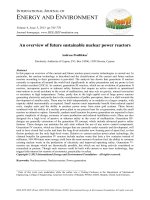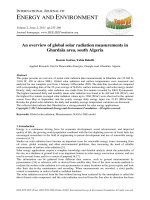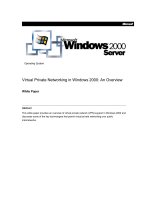Plastic recycling: an overview
Bạn đang xem bản rút gọn của tài liệu. Xem và tải ngay bản đầy đủ của tài liệu tại đây (483.78 KB, 11 trang )
30/01/2013
Plastic recycling - Wikipedia, the free encyclopedia
Plastic recycling
From Wikipedia, the free encyclopedia
Plastic recycling is the process of recovering scrap or waste plastic and reprocessing the material into useful
products, sometimes completely different in form from their original state. For instance, this could mean melting
down soft drink bottles and then casting them as plastic chairs and tables. Typically a plastic is not recycled into the
same type of plastic, and products made from recycled plastics are often not recyclable.[citation needed]
Contents
1 Challenges
2 Processes
2.1 Monomer recycling
2.2 Thermal depolymerization
2.3 Heat compression
2.4 Other processes
3 Applications
3.1 PET
3.2 PVC
3.3 HDPE
3.4 PS
3.5 Other plastics
4 Recycling rates
5 Economic and energy potential
6 Consumer education
6.1 United States
6.2 United Kingdom
7 Plastic identification code
8 See also
9 References
10 External links
Challenges
When compared to other materials like glass and metal, plastic polymers require greater processing (heat treating,
thermal depolymerization and monomer recycling) to be recycled.[citation needed] Due to the high molecular weight
of their large polymer chains, plastics have a low entropy of mixing. A macro molecule interacts with its environment
along its entire length, so total energy involved in mixing it is large compared to that of an organic molecule with a
similar structure (see enthalpy). Heating alone is not enough to dissolve such a large molecule, so plastics must often
be of nearly identical composition to mix efficiently.
When different types of plastics are melted together, they tend to phase-separate, like oil and water, and set in
en.wikipedia.org/wiki/Plastic_recycling
1/11
30/01/2013
Plastic recycling - Wikipedia, the free encyclopedia
these layers. The phase boundaries cause structural weakness in the resulting material, meaning that polymer blends
are useful in only limited applications.
Another barrier to recycling is the widespread use of dyes, fillers, and other additives in plastics. The polymer is
generally too viscous to economically remove fillers, and would be damaged by many of the processes that could
cheaply remove the added dyes. Additives are less widely used in beverage containers and plastic bags, allowing
them to be recycled more often. Yet another barrier to removing large quantities of plastic from the waste stream
and landfills is the fact that many common but small plastic items lack the universal triangle recycling symbol and
accompanying number. A perfect example is the billions of plastic utensils commonly distributed at fast food
restaurants or sold for use at picnics.[citation needed]
The use of biodegradable plastics is increasing.[1] If some of these get mixed in with the other plastics for recycling,
the reclaimed plastic is not recyclable because of the variance in properties and melt temperatures.[citation needed]
Processes
Before recycling, most plastics are sorted according to their resin type. In the past, plastic reclaimers used the resin
identification code (RIC), a method of categorization of polymer types, which was developed by the Society of the
Plastics Industry in 1988. Polyethylene terephthalate, commonly referred to as PET, for instance, has a resin code
of 1. Most plastic reclaimers do not rely on the RIC now; they use automatic sort systems to identify the resin, such
as near infrared (NIR) technology. Some plastic products are also separated by color before they are recycled.
The plastic recyclables are then shredded. These shredded fragments then undergo processes to eliminate impurities
like paper labels. This material is melted and often extruded into the form of pellets which are then used to
manufacture other products.
Monomer recycling
Many recycling challenges can be resolved by using a more elaborate monomer recycling process, in which a
condensation polymer essentially undergoes the inverse of the polymerization reaction used to manufacture it. This
yields the same mix of chemicals that formed the original polymer, which can be purified and used to synthesize new
polymer chains of the same type. Du Pont opened a pilot plant of this type in Cape Fear, North Carolina, USA, to
recycle PET by a process of methanolysis, but it closed the plant due to economic pressures.[2][3]
Thermal depolymerization
Main article: Depolymerization
Main article: Thermal depolymerization
Another process involves the conversion of assorted polymers into petroleum by a much less precise thermal
depolymerization process. Such a process would be able to accept almost any polymer or mix of polymers,
including thermoset materials such as vulcanized rubber tires and the biopolymers in feathers and other agricultural
waste. Like natural petroleum, the chemicals produced can be made into fuels as well as polymers. A pilot plant of
this type exists in Carthage, Missouri, USA, using turkey waste as input material. Gasification is a similar process,
but is not technically recycling since polymers are not likely to become the result.
Heat compression
en.wikipedia.org/wiki/Plastic_recycling
2/11
30/01/2013
Plastic recycling - Wikipedia, the free encyclopedia
Yet another process that is gaining ground with startup companies (especially in Australia, United States and Japan)
is heat compression.[citation needed] The heat compression process takes all unsorted, cleaned plastic in all forms,
from soft plastic bags to hard industrial waste, and mixes the load in tumblers (large rotating drums resembling giant
clothes dryers). The most obvious benefit to this method is the fact that all plastic is recyclable, not just matching
forms. However, criticism rises from the energy costs of rotating the drums, and heating the post-melt pipes.
Other processes
A process has also been developed in which many kinds of plastic can be used as a carbon source in the recycling
of scrap steel.[4]
Applications
PET
Main article: PET bottle recycling
Post-consumer polyethylene terephthalate (PET or PETE)
containers are sorted into different colour fractions, and baled for
onward sale. PET recyclers further sort the baled bottles and they
are washed and flaked (or flaked and then washed). Non-PET
fractions such as caps and labels are removed during this process.
The clean flake is dried. Further treatment can take place e.g. melt
filtering and pelletising or various treatments to produce foodcontact-approved recycled PET (RPET).
RPET has been widely used to produce polyester fibres.[5] This
sorted post-consumer PET waste is crushed, chopped into flakes,
pressed into bales, and offered for sale.[6]
Bales of PET bottles to be recycled.
One use for this recycled PET that has recently started to become popular is to create fabrics to be used in the
clothing industry.[7] The fabrics are created by spinning the PET flakes into thread and yarn.[6] This is done just as
easily as creating polyester from brand new PET.[8] The recycled PET thread or yarn can be used either alone or
together with other fibers to create a very wide variety of fabrics. Traditionally these fabrics were used to create
strong, durable, rough, products, such as jackets, coat, shoes, bags, hats, and accessories. However, these fabrics
are usually too rough on the skin and could cause irritation. Therefore, they usually are not used on any clothing that
may irritate the skin, or where comfort is required.[9] But in today's new eco-conscious world there has been more
of a demand for "green" products. As a result, many clothing companies have started looking for ways to take
advantage of this new market and innovations in the use of recycled PET fabric are beginning to develop. These
innovations included different ways to process the fabric,[6] to use the fabric, or blend the fabric with other
materials.[10] Some of the fabrics that are leading the industry in these innovations include Billabong's Eco-Supreme
Suede,[10] Livity ( 's Rip-Tide III,[11] Wellman Inc ( 's Ecofi(formerly known as EcoSpun),[5] and Reware ( 's Rewoven.[8] Some additional
companies that take pride in using recycled PET in their products are Rethink Fabrics ()
,[12] Crazy Shirts[13] and Playback ( .[7]
en.wikipedia.org/wiki/Plastic_recycling
3/11
30/01/2013
Plastic recycling - Wikipedia, the free encyclopedia
Other major outlets for RPET are new containers (food-contact or non-food-contact) produced either by (injection
stretch blow) moulding into bottles and jars or by thermoforming APET sheet to produce clam shells, blister packs
and collation trays. These applications used 46% of all RPET produced in Europe in 2010. Other applications,
such as strapping tape, injection-moulded engineering components and even building materials account for 13% of
the 2010 RPET production.
PVC
In Europe, developments in PVC waste management are monitored by Vinyl 2010,[14] a
legal entity established in 2000. In the waste management area their commitment is to
1. Support integrated waste management approaches, using raw materials as efficiently as
possible;
2. Work with the stakeholders to research, develop, and implement recycling of 200,000
tonnes per year of PVC postconsumer waste in 2010 in addition to waste already
recycled in 2000, or regulated by the PPW, ELV and E&E Waste Directives;
3. Recycle collectable, available PVC postconsumer waste from pipes, window profiles,
and roofing membranes.
Vinyl 2010 has a Monitoring Committee and publishes annual reviews.[15][16] In 2011, it
reported that 260,842 tonnes of post-consumer PVC waste was recycled in 2010, i.e. an
increase of 220,000 tonnes over the 1999 volumes, exceeding the 10-year target of 200,000
tonnes.
PVC SPI code,
for recycling
(Society of the
Plastics
Industry). The
Unicode
character for
this symbol is
U+2675.
Collection and recycling schemes for the PVC waste stream are managed through
Recovinyl[17] which reported the recycled tonnage as follows: profile 107,000 tonnes; flexible
cables 79,000 tonnes; pipe 25,000 tonnes; rigid film 6,000 tonnes; and mixed flexible 38,000 tonnes. Recovinyl
states that of the recycled material, 75% is for floors, 15% for foils, 5% for traffic cones, 3% for hoses end 2% for
other applications.
One of the recycling processes is the Vinyloop Texyloop[18] used for solvent-based mechanical recycling. It
involves recovering PVC plastic from composite materials through dissolution and precipitation, and is a closedloop system, recycling the solvent and regenerating PVC. It offers a major ecological benefit, as Vinyloop-based
recycled PVC's primary energy demand is 46 percent lower than conventional produced PVC. The global warming
potential is 39 percent lower. This is why the use of recycled material leads to a significant better ecological
footprint.[19]
HDPE
The most-often recycled plastic[citation needed], HDPE (high-density polyethylene) or number 2, is downcycled into
plastic lumber, tables, roadside curbs, benches, truck cargo liners, trash receptacles, stationery (e.g. rulers) and
other durable plastic products and is usually in demand.
PS
Most polystyrene products are currently not recycled due to the lack of incentive to invest in the compactors and
logistical systems required. As a result, manufacturers cannot obtain sufficient scrap. Expanded polystyrene scrap
en.wikipedia.org/wiki/Plastic_recycling
4/11
30/01/2013
Plastic recycling - Wikipedia, the free encyclopedia
can be easily added to products such as EPS insulation sheets and other EPS materials for construction
applications. When it is not used to make more EPS, foam scrap can be turned into clothes
hangers, park benches, flower pots, toys, rulers, stapler bodies, seedling containers, picture
frames, and architectural molding from recycled PS.[20]
Recycled EPS is also used in many metal casting operations. Rastra is made from EPS that is
combined with cement to be used as an insulating amendment in the making of concrete
foundations and walls. Since 1993, American manufacturers have produced insulating
concrete forms made with approximately 80% recycled EPS.
Other plastics
The white plastic polystyrene foam peanuts used as packing material are often accepted by
shipping stores for reuse.[21]
The resin
identification
code symbol for
polystyrene
Successful trials in Israel have shown that plastic films recovered from mixed municipal waste streams can be
recycled into useful household products such as buckets.[22]
Similarly, agricultural plastics such as mulch film, drip tape and silage bags are being diverted from the waste stream
and successfully recycled[23] into much larger products for industrial applications such as plastic composite railroad
ties.[24] Historically, these agricultural plastics have primarily been either landfilled or burned on-site in the fields of
individual farms.[25]
CNN reports that Dr. S. Madhu of the Kerala Highway Research Institute, India, has formulated a road surface
that includes recycled plastic: aggregate, bitumen (asphalt) with plastic that has been shredded and melted at a
temperature below 220 degrees C (428 °F) to avoid pollution. This road surface is claimed to be very durable and
monsoon rain resistant. The plastic is sorted by hand, which is economical in India. The test road used 60 kg of
plastic for an approximately 500m-long, 8m-wide, two-lane road. The process chops thin-film road-waste into a
light fluff of tiny flakes that hot-mix plants can uniformly introduce into viscous bitumen with a customized dosing
machine. Tests at both Bangalore and the Indian Road Research Centre indicate that roads built using this 'KK
process' will have longer useful lives and better resistance to cold, heat, cracking, and rutting, by a factor of
three.[26]
Recycling rates
The quantity of post-consumer plastics recycled has increased every year since at least 1990, but rates lag far
behind those of other items, such as newspaper (about 80%) and corrugated fiberboard (about 70%).[27] Overall,
U.S. post-consumer plastic waste for 2008 was estimated at 33.6 million tons; 2.2 million tons (6.5%) were
recycled and 2.6 million tons (7.7%) were burned for energy; 28.9 million tons, or 85.5%, were discarded in
landfills.[28]
Economic and energy potential
In 2008, the price of PET dropped from $370/ton in the US to $20 in November.[29] PET prices had returned to
their long term averages by May 2009.[30]
en.wikipedia.org/wiki/Plastic_recycling
5/11
30/01/2013
Plastic recycling - Wikipedia, the free encyclopedia
Consumer education
United States
Low national plastic recycling rates have been due to the complexity of sorting and processing, unfavorable
economics, and consumer confusion about which plastics can actually be recycled.[31] Part of the confusion has
been due to the recycling symbol that is usually on all plastic items[citation needed]. This symbol is called a resin
identification code. It is stamped or printed on the bottom of containers and surrounded by a triangle of arrows.
(See the table in Plastic.) The intent of these arrows was to make it easier to identify plastics for recycling. The
recycling symbol doesn't necessarily mean that the item will be accepted by residential recycling programs.[32]
United Kingdom
In the UK, the amount of post-consumer plastic being recycled is relatively low,[33] due in part to a lack of
recycling facilities.
The Plastics 2020 Challenge was founded in 2009 by the plastics industry with the aim of engaging the British
public in a nationwide debate about the use, reuse and disposal of plastics, and hosts a series of online debates on
its website framed around the waste hierarchy.
There is a facilities in Worksop capable of 60 - 80 thousand metric tonnes a year.[34]
Plastic identification code
Main article: Resin identification code
Five groups of plastic polymers,[35] each with specific properties, are used worldwide for packaging applications
(see table below). Each group of plastic polymer can be identified by its Plastic Identification code (PIC) – usually
a number or a letter abbreviation. For instance, Low-Density Polyethylene can be identified by the number "4" or
the letters "LDPE". The PIC appears inside a three-chasing-arrow recycling symbol. The symbol is used to indicate
whether the plastic can be recycled into new products.[citation needed]
The PIC was introduced by the Society of the Plastics Industry, Inc., to provide a uniform system for the
identification of different polymer types and to help recycling companies separate different plastics for reprocessing.
Manufacturers of plastic products are required to use PIC labels in some countries/regions and can voluntarily mark
their products with the PIC where there are no requirements.[36] Consumers can identify the plastic types based on
the codes usually found at the base or at the side of the plastic products, including food/chemical packaging and
containers. The PIC is usually not present on packaging films, as it is not practical to collect and recycle most of this
type of waste.[citation needed]
Plastic
Identification
Code
Type of
plastic
polymer
en.wikipedia.org/wiki/Plastic_recycling
Properties
Common Packaging
Applications
Glass
Transition
and Melting
Temperatures
(°C)
Young's
Modulus
(GPa)
6/11
30/01/2013
Plastic recycling - Wikipedia, the free encyclopedia
Clarity,
Soft drink, water and salad
Polyethylene strength,
dressing bottles; peanut butter
terephthalate toughness,
(PET, PETE) barrier to gas and jam jars
and moisture.
Tm = 250;[37]
2-2.7[38]
[37]
Tg = 76
Stiffness,
strength,
toughness,
resistance to
moisture,
permeability
to gas.
Water pipes, hula hoop rings,
five gallon buckets, milk, juice Tm = 130;[39]
0.8[38]
and water bottles; grocery bags, Tg = -125[40]
some shampoo / toiletry bottles
Polyvinyl
chloride
(PVC)
Versatility,
ease of
blending,
strength,
toughness.
Blister packaging for non-food
items; cling films for non-food
use. Not used for food
packaging as the plasticisers
needed to make natively rigid
PVC flexible are usually toxic.
Non-packaging uses are
electrical cable insulation; rigid
piping; vinyl records.
Tm = 240;[41]
2.4-4.1[42]
Tg = 85[41]
Low-density
polyethylene
(LDPE)
Ease of
processing,
strength,
toughness,
flexibility,
ease of
sealing,
barrier to
moisture.
Frozen food bags; squeezable
bottles, e.g. honey, mustard;
cling films; flexible container
lids.
Tm = 120;[43]
0.17-0.28[42]
[44]
Tg = -125
High-density
polyethylene
(HDPE)
Strength,
toughness,
resistance to
heat,
Polypropylene
chemicals,
(PP)
grease and
oil, versatile,
barrier to
moisture.
Polystyrene
(PS)
en.wikipedia.org/wiki/Plastic_recycling
Reusable microwaveable ware;
kitchenware; yogurt containers;
margarine tubs; microwaveable Tm = 173;[45]
1.5-2[38]
disposable take-away
Tg = -10[45]
containers; disposable cups;
plates.
Egg cartons; packing peanuts;
Versatility,
disposable cups, plates, trays
clarity, easily
and cutlery; disposable takeformed
Tm = 240
(only
isotactic);[40]
Tg = 100
3-3.5[38]
7/11
30/01/2013
Plastic recycling - Wikipedia, the free encyclopedia
away containers;
(atactic and
isotactic)[40]
Beverage bottles; baby milk
bottles. Non-packaging uses for
polycarbonate: compact discs;
Polycarbonate:
Dependent on
"unbreakable" glazing; electronic Polycarbonate:
Other (often
polymers or
2.6;[38] ABS
apparatus housings; lenses
polycarbonate
Tg = 145;[47]
combination
plastics:
[48]
including sunglasses,
or ABS)
Tm
=
225
of polymers
2.3[38]
prescription glasses, automotive
headlamps, riot shields,
instrument panels;[46]
See also
Baler
Bisphenol_A#Identification_in_plastics, an article on "BPA", esp. relevant to types 3 & 7 plastics.
Clean Value Plastics
Microplastics
Phase-out of lightweight plastic bags
Plastics 2020 Challenge
Post-consumer resin sterilization
Reuse of water bottles
References
1. ^ Hatti-Kaul, Rajni. "Industrial biotechnology for the production of bio-based chemicals – a cradle-to-grave
perspective" ( . Trends in
Biotechnology. Lund University. />cc=y. Retrieved 26 August 2012.
2. ^ "DUPONT ENDS RECYCLING EXPERIMENT. | Chemicals > Chemicals Overview from"
( . AllBusiness.com.
Retrieved 2010-08-21.
3. ^ "DUPONT ENDS TRIAL."
( .
Waste&Recycling News. Retrieved 2012-09-08.
4. ^ Steel ( CNN. Retrieved 9.11.06.
5. ^ a b "EcoSpun (Eco-fi) Clothing - Eartheasy.com Solutions for Sustainable Living"
( . Eartheasy.com. />Retrieved 2010-08-21.
6. ^ a b c Idea TV GmbH. "Recycled plastic - the fashion fabric of the future" ( . Innovations-report.com.
en.wikipedia.org/wiki/Plastic_recycling
8/11
30/01/2013
7.
8.
9.
10.
11.
12.
13.
14.
15.
16.
17.
18.
19.
20.
21.
22.
23.
24.
25.
26.
27.
28.
Plastic recycling - Wikipedia, the free encyclopedia
Retrieved 2010-08-21.
^ a b 10:24 AM PT, November 13, 2009 (2009-11-13). "Trashy Chic: Recycled clothing from Playback - Brand X"
( . Thisisbrandx.com.
Retrieved 2010-08-21.
^ a b "Reware's REWOVEN Technology Info: The Eco Narrative - Recycled PET"
( . Rewarestore.com.
Retrieved 2010-08-21.
^ "Billabong ECO Supreme Suede Boardshorts: Sustainable is Good Eco Products"
( . Sustainableisgood.com. 2008-04-09.
Retrieved 2010-08-21.
^ a b [1] ( />^ "Rip-Tide "Eco Tech" Fabric Made From Hemp, Recycled PET" ( . TreeHugger. Retrieved 2010-08-21.
^ "Garbage Fashion: T-Shirts Made From Recycled Bottles" ( . .+2012-03-20.
/>^ September 3, 2009 (2009-09-03). "Eco Friendly Recycled Board Shorts" ( . Gogreenstreet.com. Retrieved 2010-08-21.
^ Home – Vinyl 2010 The European PVC industry commitment to Sustainability () .
Vinyl2010.org (2011-06-22). Retrieved on 2011-10-06.
^ Vinyl 2010. Reporting on the activities of the year 2010 and summarising the key milestones of the past 10 years
( . The
European PVC Industry's Sustainable Development Programme
^ Buekens, Alfons; Arjen Sevenster (2010). "Vinyl 2010 – nearing the target date". J Mater Cycles Waste Manag
12: 184–192. doi:10.1007/s10163-010-0286-9 ( .
^ Incentives to collect and recycle () . Recovinyl. Retrieved on 2011-10-06.
^ Texyloop : recyclage de textiles PVC ( . Texyloop.com. Retrieved
on 2011-10-06.
^ [2]
( />-Footprint%20Study.pdf)
^ Polystyrene recycling. ( Polystyrene packaging council.
Retrieved on 2009-03-06.
^ "Let Peanuts Live! Mail Boxes Etc. Recycles as Part of National Effort; Recycle Loose-fill, Foam 'Peanuts' At
Participating Mail Boxes Etc. Locations" ( . AllBusiness.com. Retrieved 2010-08-21.
^ Plastic trial procedure ( Oaktech Environmental
website. Retrieved 9.11.06.
^ Agricultural plastics recycling process ( Agricultural plastics recycling
website. Retrieved 07.11.08.
^ Plastic Composite Railroad Tie Facts ( Plastic Composite Railroad Ties
website. Retrieved 01.21.08.
^ Recycling Used Agricultural Plastics ( James W. Garthe, Paula D. Kowal, PennState University, Agricultural and Biological Engineering
^ Patel, Almitra H. (October 2003), Plastics Recycling and The Need For Bio-Polymers
( , 9, EnviroNews Archives, />^ The Self-Sufficiency Handbook: A Complete Guide to Greener Living by Alan Bridgewater pg. 62--Skyhorse
Publishing Inc., 2007 ISBN 1-60239-163-7, ISBN 978-1-60239-163-5
^ ""Energy and Economic Value of Non-recycled Plastics and Municipal Solid Wastes" at Journalist's
Resource.org" ( .
en.wikipedia.org/wiki/Plastic_recycling
9/11
30/01/2013
29.
30.
31.
32.
33.
34.
35.
36.
37.
38.
39.
40.
41.
42.
43.
44.
45.
46.
47.
48.
Plastic recycling - Wikipedia, the free encyclopedia
/>^ Page, Candace, Waste district raises recycling fees, Burlington Free Press, November 12, 2008
^ Financial Times, May 15, 2009 (article by Max Hogg)
^ Watson, Tom (June 2, 2007). "Where can we put all those plastics?"
( . Seattle Times.
Retrieved 2007-06-02.
^ Where can we put all those plastics? By Tom Watson June 2, 2007 Seattle Times
/>^ Plastics ( wasteonline.org.uk.
Retrieved 10.18.07.
^ />^ "Safe Use Of Plastic Food Packaging And Containers"
( .
/>^ "19". Holt Chemistry (Florida edition). Holt, Rinehart, and Winston. 2006. p. 702. ISBN 0-03-039114-8. "More
than hlf the states in the United States have enacted laws that require plastic products to be labeled with numerical
codes that identify the type of plastic used in them."
^ a b [3] ( PolymerProcessing.com
^ a b c d e f [4] ( The Engineering Toolbox
^ [5] ( Dyna Lab Corp
^ a b c [6]
( />rs.Par.0001.File.tmp/thermal_transitions_of_homopolymers.pdf) Sigma Aldrich
^ a b [7] ( PolymerProcessing.com
^ a b Modern Plastics Encyclopedia 1999, p B158 to B216.(Tensile Modulus)
^ [8] ( Dyna Lab Corp
^ [9] ( Wofford University
^ a b [10] ( PolymerProcessing.com
^ "What is Polycarbonate (PC)?" ( .
/>^ "polycarbonate information and properties" ( .
Polymerprocessing.com. 2001-04-15. Retrieved 2012-1027.
^ [11] ( PolymerProcessing.com
External links
West, Larry. "Recyclable Plastic: Why are So Few Food Containers Made of Recyclable Plastic?"
( . About.com.
Retrieved 2009-05-04.
Plastic Packaging Resin Codes ( />CID=1102&DID=4645&DOC=FILE.PDF) data from the American Chemistry Council
ISF's Plastics Recovery Manual
American Chemistry Council Statement on Plastic Recycling
( />Technology for plastic recycling ( />Mike Biddle we can recycle plastic ( />Visit Earth911 to find locations to drop off plastics that are not recycled by your municipality
en.wikipedia.org/wiki/Plastic_recycling
10/11
30/01/2013
Plastic recycling - Wikipedia, the free encyclopedia
( />Retrieved from " />Categories: Plastic recycling
Navigation menu
This page was last modified on 29 January 2013 at 09:55.
Text is available under the Creative Commons Attribution-ShareAlike License; additional terms may apply.
See Terms of Use for details.
Wikipedia® is a registered trademark of the Wikimedia Foundation, Inc., a non-profit organization.
en.wikipedia.org/wiki/Plastic_recycling
11/11









